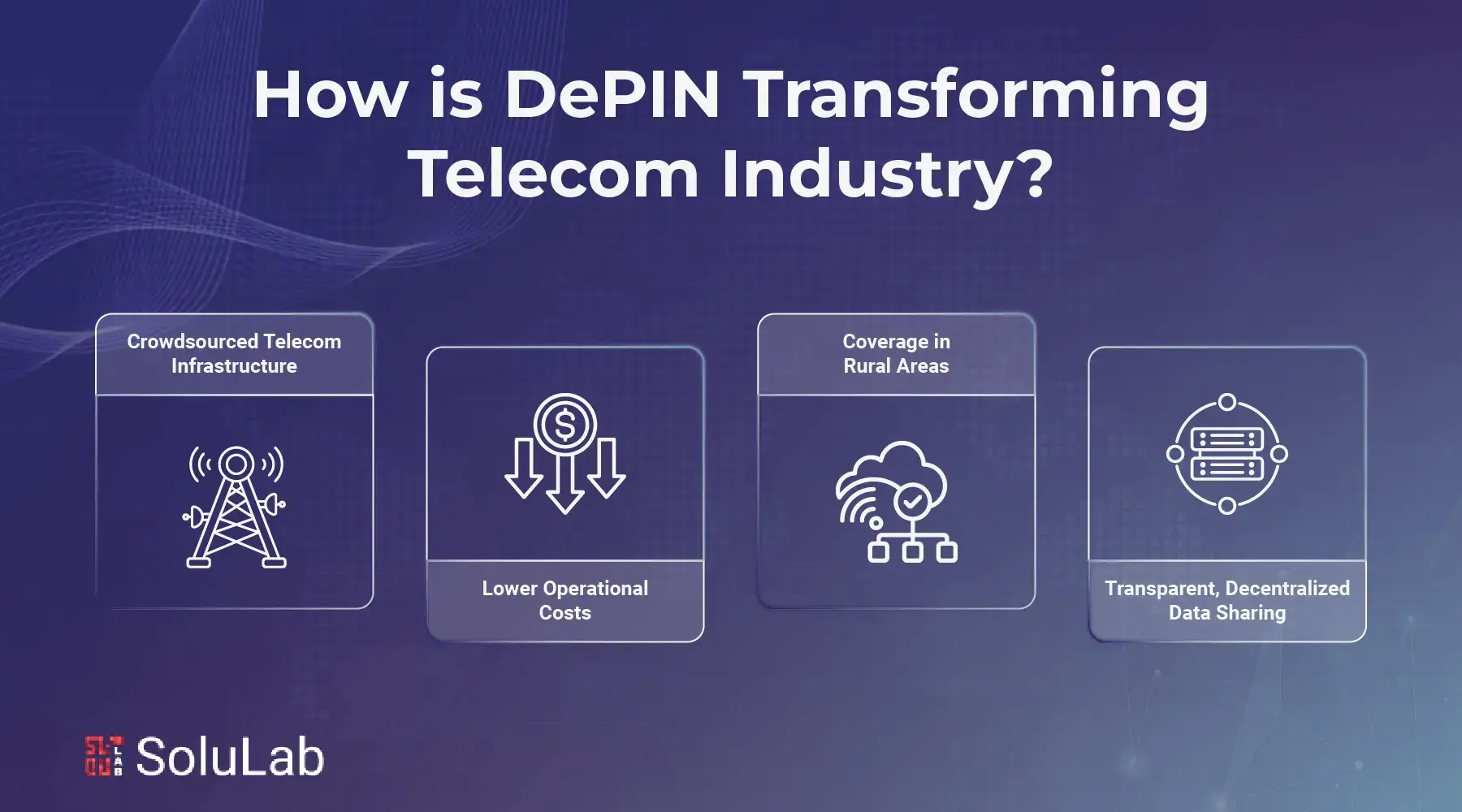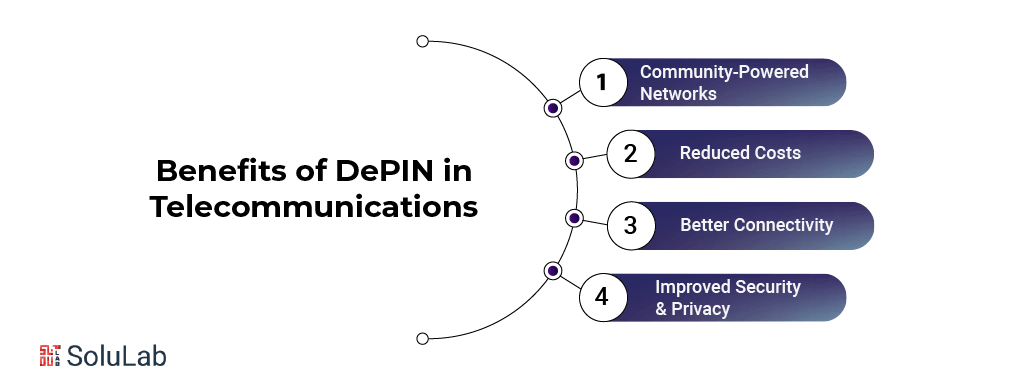
The telecom industry has high infrastructure costs and patchy services, especially in rural or underserved areas. Traditional telecom models are expensive to build, slow to scale, and often fail to serve the needs of the entire population. Many regions still suffer from poor connectivity and a lack of transparency in data handling.
According to predictions, the global telecom services market is expected to grow from its 2023 valuation of $1.7 trillion to $3.5 trillion by 2028.
Offering decentralized, community-driven solutions, especially in poor regions, is how DePIN projects want to take a piece of this market. DePIN is reducing costs, increasing coverage, and introducing unprecedented flexibility to telecom by crowd-powering infrastructure and compensating individuals for their involvement.
It’s a brand-new, community-focused approach to network development and management that has already changed how we communicate. As demand grows, DePIN development services are playing a crucial role in building and scaling these decentralized networks. Let’s explore how DePIN’s role in telecommunication is changing the game for all of us.
Benefits of DePIN in Telecommunications

DePIN (Decentralized Physical Infrastructure Networks) is causing a change. Here are some benefits of DePIN in telecommunications:
- Community-Powered Networks: Individuals and companies can install and manage network equipment (such as cell towers and Wi-Fi hotspots) and receive incentives for offering coverage, eliminating the need to rely on big telecom companies.
- Reduced Costs: Large capital expenditures are necessary for traditional communication networks. By sharing expenses among participants, DePIN reduces this burden and makes network expansion more feasible.
- Better Connectivity: By offering coverage in underdeveloped or isolated locations where traditional carriers have little financial incentive, DePIN can aid in closing the digital divide.
- Improved Security & Privacy: DePIN networks can provide more secure communication by lowering the dangers of centralized data breaches using blockchain-based authentication and encryption.
How is DePIN Transforming Telecom?
Decentralized Telecom Physical Infrastructure Networks have caused an uproar in the telecom industry. It utilizes the power of the community rather than relying on large telecom companies. One hotspot at a time, let’s see how it is altering the game.
1. Crowdsourced Telecom Infrastructure
With DePIN, individuals can contribute their nodes or hotspots to the network. This allows everyday users to become mini telecom providers, reducing the need for massive infrastructure. It’s like turning your WiFi router into a building block for global connectivity!
Read Also: DePin In Web3
2. Lower Operational Costs
Because decentralized network solutions run on user-contributed hardware, companies don’t need to spend crores on cell towers or cables. Plus, pay-per-use pricing makes things more efficient for users. You only pay for what you use, no inflated monthly bills!
3. Coverage in Rural Areas
DePIN’s role in telecommunications empowers locals in remote areas to set up network nodes, filling gaps where traditional telecom skips out. Token rewards motivate participation, making connectivity both accessible and community-driven. Villages can now get online without waiting for big providers.
4. Transparent, Decentralized Data Sharing
All network data, like usage and performance, is openly accessible on the blockchain networks. This keeps things honest, helps track efficiency, and limits shady practices. Everyone can see what’s going on, which builds more trust across the board.
Real-World Examples of DePIN in Telecom
DePIN is improving telecom with community-driven networks. Explore how DePIN development services power innovations like Helium, Pollen Mobile & Nodle.
1. Helium Network
Helium is a decentralized wireless network designed for low-power IoT devices. Individuals deploy Helium Hotspots, creating a global network that provides long-range connectivity. Participants earn HNT tokens for contributing to network coverage. This model reduces reliance on traditional telecom infrastructure and supports applications like smart city sensors and asset tracking.
2. Pollen Mobile
Pollen Mobile offers user-owned, decentralized mobile network solutions focusing on privacy and affordability. Users deploy “Flowers” (small cell radios) to provide coverage, and devices connect via eSIMs. Contributors earn PollenCoin for their participation. This approach enables customizable coverage, especially in areas underserved by traditional carriers.
3. Nodle Network
Nodle Network utilizes smartphones as nodes to create a decentralized IoT network. By leveraging Bluetooth connectivity, it provides low-cost, secure connections for IoT devices. Participants earn Nodle Cash for contributing to the network, which is particularly beneficial for applications like asset tracking and smart city infrastructure.
The Future of Telecom with DePIN
Decentralized Physical Infrastructure Networks (DePIN) are changing the telecom industry. Traditional telecom models, which depend on centralized infrastructure, are having trouble being accessible, scalable, and cost-effective. Utilizing the blockchain and decentralized technology to build distributed, community-driven networks, DePIN provides an innovative solution.
With the help of tokenized telecom infrastructure rewards, people and organizations can participate in the development and maintenance of network infrastructure. DePIN makes it possible for affordable, scalable, and inclusive connectivity solutions, as shown by the Helium Network, Pollen Mobile, and Nodle Network. This strategy not only decreases dependency on big businesses but also gives communities and users the authority to take charge of their connection requirements.
DePIN development company solutions are changing telecom by boosting connectivity, cutting costs, and driving sustainable, transparent network innovation.
Conclusion
The telecom industry has long struggled with high infrastructure costs, limited rural reach, and a lack of transparency. These challenges have slowed progress and kept many communities offline. DePIN, however, is changing the course. It is increasing the efficiency and inclusivity of telecom by extending connectivity to underdeveloped places, lowering operating costs, and crowdsourcing infrastructure.
It’s all powered by communities, not corporations. If we want a future where everyone, regardless of location, can access reliable and affordable connectivity, DePIN is a step in the right direction. It’s not just an upgrade; it’s a whole new way of thinking about telecom.
SoluLab, a top DePIN development company, has its team of experts to solve your queries related to DePIN telecom. Contact us today to discuss this further!
FAQs
1. What is DePIN in telecom?
DePIN stands for Decentralized Physical Infrastructure Networks. In telecom, it refers to community-powered networks where individuals contribute hardware like hotspots to improve connectivity.
2. How does DePIN reduce telecom costs?
Since users contribute to the infrastructure, a DePIN telecom solutions provider doesn’t need to invest in expensive towers or hardware. This cuts down operational costs and enables more flexible pricing models.
3. Can DePIN work in rural areas?
Yes! Locals can set up nodes and earn rewards, helping extend coverage to regions that traditional telecom companies often ignore.
4. What are the benefits of crowdsourced telecom infrastructure?
It boosts network reach, reduces dependency on centralized providers, and opens income opportunities through tokenized telecom infrastructure for individuals who participate in building the network.
5. Is DePIN secure and reliable?
Yes. Many DePIN networks use blockchain for transparency and security. Real-time data sharing helps detect and prevent misuse or fraud.





